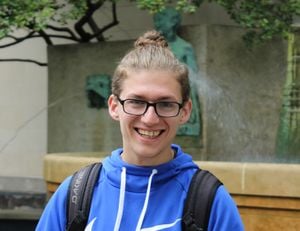
Howdy Doody, Appropedia folks. My name is Samuel Keller, but you can call me Sammy. I am a Political Science and Global Studies major at Principia College. I am currently taking ENGR 242 (3D Printing Technologies). I'll be honest, I'm mainly taking the class because it fulfills a General Education requirement (my college is a liberal arts school). However, I have come to really enjoy 3D printing and I'm saying that after just finishing the build of my Jellybox 1.3. It was incredibly frustrating, but the first print did feel very satisfying. Our professor, Dr. Marie Farson, introduced us to the world of the Open Source movement. Open Source means that everybody has free access to the project. Everybody has free access to the product, but people can also make changes, improvements, and modifications to the source and make that available to the public as well. I think that's really cool. Something like 3D printing technologies is something that is maybe not as widely spoken about because it seems to fairly complicated. Well, it is, but anybody can learn it. I have no experience in Engineering, I study Politics and I was able to do it. My only prior experience is that I played with Legos growing up. By making the products publicly available for free, it incentives people to give it a try because the investments in this technology are fairly low. Just because it is Open Sources does not mean that you can't make money from it. One of the creators of Jellybox made money by selling 3D printed replacement parts for the printer. Since we use the Jellybox model, we thereby participated in the Open Source movement. Yeehaw! Like I said previously, I've come to enjoy 3D printing and I'm kind of fascinated with how the printer works. I'm still learning to understand more about it, but I think I can see myself keeping it up in the future as a hobby.
Projects[edit | edit source]
| House Project | |
|---|---|
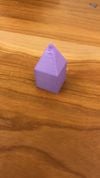
|
This was the house project that we were asked to print. It looks pretty good. There's a minor gap on the roof. I'm figuring out how to fix that. Overall, it turned out really nice, though. |
| My First Print | |
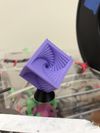
|
This was my first print. It's a spiral cube with a base to rest in. It looks really cool. I used Esteban's filament for the base. I printed this before I printed the house above. There's no issues with this print, so I'm not sure what happened between the two prints that could have messed with my prints.
By JustinSDK. Licensed under the Creative Commons - Attribution - Non-Commercial - Share Alike license.[1] |
| Jellybox Replacement Part | |
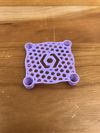
|
For this project, I decided to print a fan cover replacement part.[2] The original file had the cover all filled in, which I accidentally printed. I printed it again with a Tri-Hexagon shape with an infill density of about 50%. |
| Blender Exercise | |
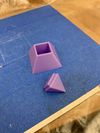
|
We learned how to use Blender (Version 2.79). I'm still figuring it out, but that's just the beauty of technology and different programs. It's quite tricky, but I think the pyramid turned out pretty well. This is the second print of this design. The face on the lid was a little too big, so I had to make it a little smaller in Blender.
Licensed under the Creative Commons - Attribution - Non-Commercial - Share Alike license. |
| FreeCAD Exercise | |
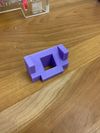
|
We learned the basics of FreeCAD. We designed the design you can see in the picture in class and printed it. I really like how it turned out. I printed it with 10% infill % and 0.3mm layer height. I really did not like working with this program. I kept getting error messages, despite using different computers and following the tutorial step by step. I definitely like Blender a lot better.
Licensed under the Creative Commons - Attribution - Non-Commercial - Share Alike license. |
| OpenSCAD Exercise | |
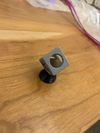
|
We learned the basics of OpenSCAD. We designed this coin holder and we reshaped a rock wall holder for homework. I think that this program is definitely easy to use when you're good with coding, but this program is seriously giving me a headache. I hate that it doesn't tell me what's wrong. It just puts a red dot somewhere and then I check on that line, but there's nothing wrong on that line.
Licensed under the Creative Commons - Attribution - Non-Commercial - Share Alike license. |
| Science Equipment | |
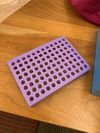
|
Now that we learned the basics of the various programs, we were tasked to design a piece of science equipment for one of the science professors at our college. I got in touch with one of our Biology professors, Chrissy, and asked her if she needed something. She asked me to design an adaptor for one of her test tube cold blocks. She was having trouble with it. The holes on the cold block were too big and wouldn't hold the tubes properly in place. The adaptor that I designed is just put over the actual holes and adds a thin layer (2 mm) so that the tubes still sit in the cold block. I had six prints total, including the prototype. Given that this is 3D printed and can be modified, it meant that the professor didn't have to buy a new cold block, which would have cost her upwards of $100. Instead, this was less than $1 worth of filament (not including time for designing it).
Designed in FreeCad. |
| OSAT Project Prototype | |
| For our next project, we went onto the OSAT project requests page on Appropedia and picked a project to work on. I'm currently working on a pill holder to hold daily pills for up to 14 days that someone requested. This is my prototype so far- I'm currently trying to figure out how to make it better and come up with a creative way for the lid to only open one compartment at a time so that all the pills don't fall out if you were to knock it over while having a compartment open.
Designed in FreeCad. Licensed under the Creative Commons - Attribution - Non-Commercial - Share Alike license. | |
| OSAT Project Final | |
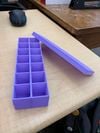
|
For our next project, we went onto the OSAT project requests page on Appropedia and picked a project to work on. I created a pill holder to hold daily pills for up to 14 days that a professor at Penn State University requested. This is my final project. I initially had a different idea for the lid that would be more efficient and prevent pills from flying everywhere if the dispenser was to be knocked over, but my idea didn't work out, unfortunately. The plan was to have separate slide-in lids, but they wouldn't hold properly. Therefore I went with a standard lid. These pill holders are usually pretty cheap, the closest one to this that I found at $6 a piece [3], but you don't really find pill holders for more than a week, so that's where this design has a leg up to commercially sold pill holders.
My pill holder has a production cost of roughly $2.5 (65 grams total at roughly 4ct/gram), so you save roughly 60% of the cost. The file can be downloaded here [4] Licensed under the Creative Commons - Attribution - Non-Commercial - Share Alike license. |
| Big $$$ Project | |
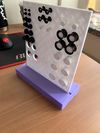
|
This is my final project of the semester, aka the BIG MONEY Project. For my final project, I decided to design an earring holder. However, it's not a traditional earring holder. This one is designed specifically for gauges and the expanders used for gauges in the stretching set. There are no official numbers for how many people wear gauges, but it's been increasing since 2011, therefore it's a pretty significant market. I based my design on this stretcher set, which is the standard set that I used. [5] I looked around on amazon and other websites, but I couldn't find a gauge holder that lets you organize your gauges and the stretchers. I based my evaluation of savings on this jewelry box that is suggested when you look for a gauge organizer. [6]. It goes for $33. My design, which comes in two parts and takes about 7 hours to print, costs about $4.30 (107 gram at 4ct/gram). The savings on this comes out to about $28, or 86%. Another advantage of my design is that it actually lets you organize the stretchers as well, which the one marketed on amazon does not.
This was designed in FreeCad and the files can be downloaded on thingiverse.com [7] Licensed under the Creative Commons - Attribution - Non-Commercial - Share Alike license. |